Visual effects - Dissociatives
This article attempts to break down the visual effects contained within the dissociative experience into simple, easy to understand titles, descriptions and levelling systems. This is done without depending on metaphors, analogies or personal trip reports. The article starts off with descriptions of the simpler effects and works its way up towards more complex experiences as it progresses, using image examples wherever possible...
Suppression
Double vision
Double vision (also known as diplopia) is medically defined as the experience of seeing a single object as a separate image by each eye[1][2], similar to that which occurs when one crosses their eyes. Depending on the intensity, this effect can result in a reduced ability to function and perform basic tasks which necessitate the use of sight.
The effect can easily be suppressed by closing one eye. This suggests that double vision may occur when the brain overlays the data received from both eyes on top of each other incorrectly, without merging the information into a singular 3-dimensional image as it normally would during everyday life.
This effect is capable of manifesting across the 3 different levels of intensity described below:
- Subtle - At the lowest level, double vision is subtle and mostly ignorable in a manner which, although obviously present, is still not intense enough to render the person incapable of perceiving visual details necessary for tasks such as reading text or crossing a busy street.
- Distinct - At this level, double vision becomes intense enough to result in extreme difficulty performing tasks which require the perception of fine details, such as reading. However, the perception of large-scale details such as the person's general environment tends to remain readily perceivable with both eyes open.
- Intense - At the highest level, double vision becomes so intense that the person will no longer be able to accurately perceive small and large-scale visual details of their environment. This will necessitate that the person closes one of their eyes at all time in order to function as they would sober.
Double vision is often accompanied by other coinciding effects such as visual acuity suppression and pattern recognition suppression. This effect is most commonly induced under the influence of moderate dosages of depressant and dissociative compounds, such as alcohol, quetiapine, ketamine, and DXM.[3] However, it can also occur much less consistently under a wide range of other classes of compounds such as hallucinogens, stimulants, anticholingerics, SSRI's, opioids, GABAergics, and cannabinoids.
Image examples
| Caption | |
|---|---|
 | Double vision on a fox by Arnold Layne |
 | Double vision on a PC by Arnold Layne |
 | Double vision at a desk by Anonymous |
 | Desktop double vision by Chelsea Morgan |
 | Double vision in a kitchen by Anonymous |
Visual acuity suppression

Visual acuity suppression is defined as the degradation of the sharpness and clarity of vision, resulting in vision becoming partially to completely blurred and indistinct.[3] This effect may affect the entirety of the person's vision or specific sections of it. The experience of this acuity suppression is comparable to looking through an out of focus lens which degrades the detail one can see in the external environment. Depending on its intensity, this can often result in a reduced ability to function and perform basic tasks which necessitate the use of sight.
Visual acuity suppression is often accompanied by other coinciding effects such as double vision and pattern recognition suppression. This effect is most commonly induced under the influence of moderate dosages of depressant and dissociative compounds, such as alcohol[4], quetiapine, ketamine, and DXM.
Pattern recognition suppression
Pattern recognition suppression is defined as a partial to complete inability to mentally process and interpret visual information regardless of its clarity. For example, if one looks at an object in front of them, they will have a reduced ability to recognize what they are seeing, even if they can see the object in clear detail. This can render even the most common everyday objects as unrecognizable but holds particularly true with faces. A person experiencing this effect while looking at a face would be able to see and even describe the facial features they see but may be unable to then combine the pattern of visual information into identifying the face. It is also worth noting that this effect is comparable and likely related to the visual disorder known as visual apperceptive agnosia.[5]
Pattern recognition suppression is often accompanied by other coinciding effects such as analysis suppression and thought deceleration. It is most commonly induced under the influence of heavy dosages of dissociative or antipsychotic compounds, such as ketamine, quetiapine, PCP, and DXM. However, it can also occur to a lesser extent under the influence of extremely heavy dosages of psychedelic compounds such as LSD, psilocybin, and mescaline.
Distortions
Perspective distortions
A perspective distortion is defined as a subtle to extreme change in how a person perceives the size and distance attributed their body, to specific parts of the external environment, or to the external environment as a whole.[6]
This effect is capable of manifesting itself in 4 different ways which may reflect the failure of each respective responsible visual function.[7]
- Size distortions:
When affecting distance, perspective distortions can make things seem as if they are physically closer or further away than they usually would be. This can range from a subtle experience, such as the other side of the room feeling marginally further away than it usually would be, to an extreme experience, such as feeling as if the horizon is right in front of you.
When affecting size, perspective distortions can make things seem as if they are physically smaller or larger in terms of the sense of size that one would usually attribute to them.[12][13][14] This can range from a subtle experience, such as the room feeling marginally smaller and more cramped than it usually would be, to an extreme experience, such as feeling as if the room is hundreds of miles wide.
Perspective distortions are often accompanied by other coinciding effects such as depth perception distortions and visual disconnection. They are most commonly induced under the influence of moderate dosages of dissociative compounds, such as ketamine, PCP, MXE, and DXM.
Alice in Wonderland Syndrome

Alice in Wonderland Syndrome (AIWS) is characterized by macropsia, micropsia, pelopsia, teleopsia, altered perception of shape (meta-morphopsia), and time distortion.[15]
Feelings of suddenly having an impossibly giant or tiny body are also a very common manifestation of this effect. This feeling is already known by the scientific literature as “Alice in Wonderland Syndrome”, where it is seen as a temporary condition often associated with migraines, brain tumours, and the use of psychoactive drugs.[6][16] The effect can either be attributed to the body as a whole or specific parts of it. For example, feelings of having a huge head or tiny limbs are possible.
Environmental Orbism
Environmental orbism is defined as a visual segmentation of the external environment into circles and spheres of varying amounts and sizes. Once established, these segments can begin to slowly drift away from their original location and often change in size, leading to gaps in-between them. The space within these gaps can be either completely dark or composed of tightly bound visual geometry.
This dark space can eventually grow, progressively decreasing the size of the orbs until a person finds themselves surrounded by a dissociative hole. It is not uncommon to be able to innately feel and detect the details and layout of both the different sections of the distortion and the gaps between them.
Environmental orbism is often accompanied by other coinciding effects such as scenery slicing and visual disconnection. It is most commonly induced under the influence of moderate dosages of dissociative compounds, such as ketamine, PCP, and DXM.
Image examples
| Caption | |
|---|---|
| Galatea of the Spheres by Salvador Dalí | |
 | Coloured Dreams by Bonnie rychlak |
 | Fly Vision by Perry |
 | Tiresome Threesome by Bonnie rychlak |
Environmental cubism
Environmental cubism is defined as a visual segmentation of the external environment into squares and cubes of varying amounts and sizes.[17] Once established, these segments can begin to slowly drift away from their original location and often change in size, leading to gaps in-between them. The space within these gaps can either be completely dark or composed of tightly bound visual geometry. It is worth noting that this effect is remarkably similar in its appearance to cubist photography and artwork.
This dark space can eventually grow, progressively decreasing the size of the cubes until a person finds themselves surrounded by a dissociative hole. It is not uncommon to be able to innately feel and detect the details and layout of both the different sections of the distortion and the gaps between them.
Environmental cubism is often accompanied by other coinciding effects such as environmental orbism and visual disconnection. It is most commonly induced under the influence of heavy dosages of dissociative compounds, such as ketamine, PCP, and DXM.
Image examples
| Caption | |
|---|---|
 | Cubism woods by Chelsea Morgan |
 | Photo montage by David Hockney |
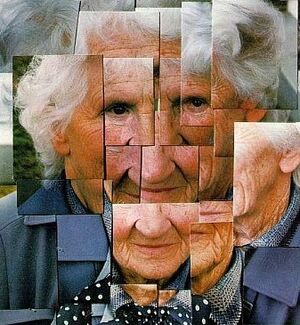 | Hockneys Mother by David Hockney |
 | Cubism Field by Chelsea Morgan |
 | Chrono Cubist by Diego Kuffer |
Scenery slicing
Scenery slicing is defined as the experience of a person's visual field appearing to split into separate cleanly cut sections, these individual slices then proceed to drift slowly away from their original position before disappearing and resetting to normalcy. This effect typically occurs spontaneously and rarely sustains itself for more than several seconds.
The organisation of these slices can be quite varied; they can be as simple as three separate sections or extremely complex, with formations such as multiple intricate slices of moving interlocking spirals or an infinite variety of other potential geometric designs.
Scenery slicing is often accompanied by other coinciding effects such as environmental cubism and visual disconnection. It is most commonly induced under the influence of moderate dosages of dissociative compounds, such as ketamine, PCP, and DXM. However, it can also occur to a lesser extent under the influence of psychedelics[18] such as LSD, psilocybin, and mescaline.
Image examples
| Caption | |
|---|---|
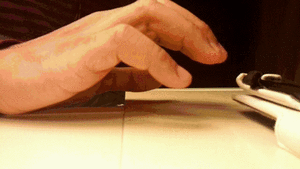 | Scenery Slicing by Subsentience |
 | Finn Jumping Rocks by Chelsea Morgan |
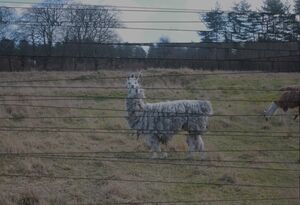 | Llama by Chelsea Morgan |
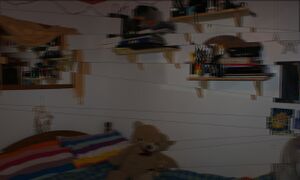 | Dissociative scenery slicing by Chelsea Morgan |
 | A Walk in the Park by Chelsea Morgan |
Geometry

Geometry (also known as visual planforms) is defined as the experience of a person's field of vision becoming partially or completely encompassed by fast-moving, colorful, and indescribably complex geometric patterns,[18][12][19][20][21][22][23] form constants,[24][25] shapes,[20] fractals,[20] and colors. These geometric forms can also become structured and organized in a manner that appears to present genuine information to the person experiencing them far beyond the perception of meaningless, although complex, shapes, and colors. The geometric representations may feel as though they depict specific concepts and neurological processes that exist within the brain in an extremely detailed manner.
Geometry is rarely motionless and is generally extremely fast-moving,[18] and self-changing in regards to its shape and style. During this process, the geometry naturally drifts laterally or radially across the visual field to create overlapping webs of geometric patterns which transition through many distinct states, all of which are visible within a single perceptual frame.
This experience is often accompanied by other coinciding effects such as internal hallucinations,[20] environmental patterning, and drifting. It is most commonly induced under the influence of moderate dosages of psychedelic compounds such as LSD,[20] psilocybin, and mescaline. However, it can also occur to a lesser extent under the influence of cannabinoids, entactogens, and dissociatives such as cannabis,[19] MDMA, and DXM.
Geometry is capable of manifesting itself across known nine different levels of intensity. These tend to depend on the dosage, but can also fluctuate wildly in their intensity due to external triggers such as a person's set and setting. The individual levels are defined below:
1. Visual noise
At the lowest level — which may be experienced in a completely sober state — geometry is perceived as visual noise (also known as visual snow, visual static, or eigengrau), combined with stray light and dark red regions that appear under the eyelids.
2. Motion and color
At this level — which is also obtainable without hallucinogens — the effect can be described as the appearance of unstructured regions of sudden flashes and clouds of color. These are typically referred to as phosphenes and can often be experienced in a sober state by rubbing or applying pressure on or near the closed eyes.
3. Partially defined geometry
At this level, relatively complex shapes and patterns with a vague structure begin to form. These patterns remain strictly two-dimensional. Geometry at this level is fine, small, and zoomed out in size with a dark color palette that typically limits itself to only a few different shades, such as blacks, reds, and dark purples. They are displayed in front of both the open and closed eye visual fields across a flat veil of geometry. However, they are significantly more detailed with the eyes closed or within dark environments.
4. Fully defined geometry
At this level, the detail in which the geometry displays itself becomes profoundly complex and fully structured, but still remains strictly two-dimensional. At this point, the geometry becomes larger in size and extremely intricate in detail with a color palette that is nearly limitless in its possibilities. They are displayed on both the open and closed eye visual field across a flat veil of geometry that floats directly before a person's eyes, remaining significantly more detailed with the eyes closed or in dark environments.
5. 3-Dimensional geometry
At this level, the geometry has become fully three-dimensional in its shape and position across the visual field. This adds a new layer of visual complexity and leaves the geometry sprawled out across the surfaces and objects of a person's environment instead of merely displaying themselves across a basic and flat veil in front of one's visual field.
6. Partially overriding visual perception
At this level, the geometry has become so intense, vivid, and bright that it has begun to block out and replace the external world. The visual perception of a person's environment begins to be replaced by geometry, with objects and scenery either transforming into complex geometric structures or simply being blocked out and covered by them. This occurs in a manner that drastically impairs the use of a person's normal vision. From this level of geometry onwards it is even possible to view geometry which is perceived to be four-dimensional or created from new, ineffable, non-euclidean, or nonsensical geometrical principles, although this is more common at higher levels.
7. Fully overriding visual perception
At this level, the geometry continues to become more intense, vivid, and bright as it begins to completely block out or replace the external world and a person's sense of normal sight become completely impaired. This creates the perception that one is no longer within the external environment, but has "broken through" into another reality of extremely complex and otherworldly geometric forms.
Level 8A and level 8B
At the highest level, geometry is capable of forking off into two separate levels of equal intensity known as level 8A and 8B. Environmental factors, a person's state of mind, and the substance consumed may determine which level a person experiences.
Once visual geometry reaches level 8A or 8B it begins to become structured and organized in a way that appears to present genuine information to the person experiencing it far beyond the preceding seven levels of relatively meaningless, although complex, shapes and colours. This occurs through the perception of innately understood geometric forms that feel as if they depict specific concepts and neurological processes that exist within the brain. Although this is also possible to a much lesser extent at lower levels it does not occur as consistently, and the intensity of it at levels 8A and 8B is significantly higher. At this point concepts can be seen as not just embedded within a person's closed or open eye visual field, but can also be simultaneously felt through indescribably complex physical and cognitive sensations.
It is worth noting that there are particular attributes of psychedelic substances which tend to result in a higher likelihood of level 8A over 8B and vice versa. Psychedelics which are physically stimulating and contain low amounts of hallucinatory content typically result in level 8A. For example, hallucinogens which tend towards causing level 8A include LSD, 2C-B, and 4-HO-MET. In contrast, psychedelics which lead to level 8B are typically sedating in physical effects and contain high amounts of hallucinatory content. For example, hallucinogens which tend towards causing level 8B include psilocybin, LSA, DMT, and 2C-T-7.
8A - Perceived exposure to semantic concept network
8A geometry is one of the two potential final levels of visual geometry; the other is 8B geometry.
A level 8A experience can be described as the feeling of being exposed to a seemingly infinite mass of geometry comprised entirely of innately comprehensible representations which are perceived to simultaneously convey every internally stored concept, memory, process, and neurological structure stored within the mind. This experience is not just perceived through visual geometric data, but is also felt in an incomprehensible level of detail that manifests in the form of complex cognitive and physical sensations. These sensations are felt to convey an equal amount of innately understandable information as that of which is also experienced through a person's vision.
At the lower end of level 8A this effect is something that fluctuates wildly and is neither constant nor consistent in its intensity. Instead, it is momentarily triggered by the experience of a concept. For example, if someone were to say the word "Internet" to a person who is currently undergoing this state they would see the mind's concept of the Internet immediately manifested in a geometric form amidst the very center of their visual field. This form will then quickly branch out from itself in a manner which is similar to a spider diagram or mind map chart, such as a network of geometric nodes descending from an origin concept where each node in the network is directly associated with their parent node, but with each degree of separation from the origin reducing the level of association with the source concept. For example, with the origin concept "Internet" one may have dozens of immediate child nodes that are representative of computers, which may have associated descendant nodes involving technologies, which may have their own children which represent human intelligence, which may also have child nodes involving all concepts related to the evolution of humanity, and so on until all concepts known to the person are represented within the network.
Once this occurs the sensory overload can temporarily disconnect one from their external environment and result in simultaneous long-term memory suppression or "ego death" for several seconds to a minute before a person is returned to reality until something triggers the process again, usually immediately. It is worth noting, however, that at this level it can to a certain extent be disabled through continuous physical movement. This seems to be because movement stops the process from branching out into everything by not giving the effect the time it needs to lock onto a concept.
As the dose of the psychoactive substance is increased, the process becomes easier to trigger while extending its length and duration. This eventually results in a stable state of complete disconnection from the external environment alongside of sustained "ego death" and a lasting sense which is often interpreted as experiencing all of existence in a single instant.
8B - Perceived exposure to inner mechanics of consciousness
8B geometry is one of the two potential final levels of visual geometry; the other is 8A geometry.
The experience of level 8B can be described as the feeling of being exposed to a mass of geometry comprised entirely of innately readable geometric representations which subjectively feel as if they convey the inner mechanics that compose all underlying neurological processes. During this experience, the organization, structure, and programming behind a person's conscious experience are perceived as conceptually understood. It is generally interpreted by those who undergo it as perceiving the supposed inner workings of either the universe, consciousness, or reality. This experience as a whole is perceived through innately understood visual geometric data and is also physically felt in an incomprehensible level of detail through accompanying complex cognitive and tactile sensations.
At the lower end of level 8B geometry, the experience manifests itself as being able to perceive the supposed organization and structure behind one's current conscious thought stream. This is typically presented in the form of a complex, multisensory, and fast-moving network that contains innately understood and relevant geometric representations of specific and abstract concepts. The experience of these innately understandable geometric representations consistently triggers one to visualize and physically feel the concept through highly detailed conceptual thinking.
At the higher end of level 8B geometry, the effect retains its lower levels but expands itself to include the experience of subjectively perceiving, through innately understandable geometric representations, the architecture of subconscious neurological processes which are usually outside of one's normal daily perception or understanding. These processes are often interpreted to include concepts such as the structure of one's neurology, memories, perspectives, emotions, and general cognitive functions.
Level 8B geometry may feel capable of bestowing specific pieces of information onto substance users regarding the nature of reality and human consciousness through the experience of them. These specific pieces of information are usually felt and understood to be a profound unveiling of an undeniable truth at the time, but afterwards they are often found to be either ineffable or simply nonsensical and delusional. Occasionally, however, genuine lessons or coherent messages are innately interpreted through this experience. It’s extremely important to note, that the scientific validity of these lessons is very uncertain and should never be immediately accepted as true without an extremely thorough and sober analysis.
It is worth noting that a greatly simplified and purely cognitive version of this effect is also capable of manifesting itself with no accompanying visual effects.
Image examples
Psychedelic artwork
| Caption | |
|---|---|
 | Untitled by Anonymous |
 | In the tree by Eddie calz |
 | Wail to god by Anthony F. Schepperd (0:50) |
 | The Phenakistoscope-diamond by Larry Carlson |
 | the eyes have eyes by meerkos |
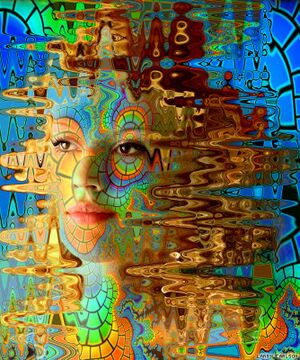 | Breakthrough by Larry Carlson |
 | Tessellation by M. C. Escher |
 | Untitled by Luke Brown |
 | Untitled by Anonymous |
 | Untitled by Anonymous |
 | Switch. by Sam Perkins |
 | Abstract by Matt W. Moore |
 | Lake on LSD by mrmedicman |
 | Magnolia Sun by Larry Carlson |
 | Untitled by Anonymous |
Fractals
| Caption | |
|---|---|
 | Fractals by Anonymous |
 | Natural Fractal - Close-up by Windy Power |
 | Fractals by Anonymous |
 | Fractals by Anonymous |
 | Fractals by Anonymous |
 | Fractals by Anonymous |
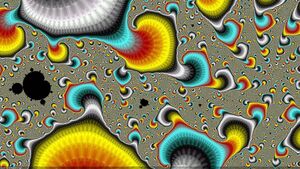 | Fractals by Anonymous |
 | Zooming into Infinity by Naps284 |
 | Fractals by Anonymous |
 | Fractals by Anonymous |
 | Fractals by Anonymous |
Shipibo textiles
| Caption | |
|---|---|
 | Untitled by Shipibo-Conibo people |
 | Untitled by Shipibo-Conibo people |
 | Untitled by Shipibo-Conibo people |
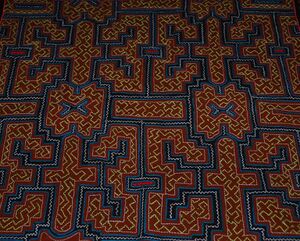 | Untitled by Shipibo-Conibo people |
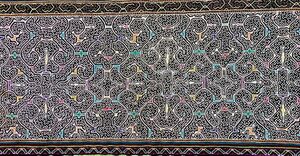 | Untitled by Shipibo-Conibo people |
 | Untitled by Shipibo-Conibo people |
 | Untitled by Shipibo-Conibo people |
 | Untitled by Shipibo-Conibo people |
 | Untitled by Shipibo-Conibo people |
 | Untitled by Shipibo-Conibo people |
 | Untitled by Shipibo-Conibo people |
 | Untitled by Shipibo-Conibo people |
 | Untitled by Shipibo-Conibo people |
 | Untitled by Shipibo-Conibo people |
 | Untitled by Shipibo-Conibo people |
 | Untitled by Shipibo-Conibo people |
 | Untitled by Shipibo-Conibo people |
Variations
The specific differences between each potential style of geometry can be broken down into the following variations:
- Intricate vs. simplistic - Geometry can either present itself as incomprehensibly intricate and complex in its appearance or simplistic, basic and comprehensible even at higher doses. For example, the geometry associated with dissociatives tends to be consistently overly simplistic in form while most psychedelics are significantly more intricate.
- Algorithmic vs. abstract - Geometry can either appear to follow mathematical rules and logically consistent forms in its design (which often results in high amounts of fractals and semi-predictable shapes). In contrast to this, however, geometry can also be completely abstract or random in its appearance in a way that contains an infinite amount of completely unpredictable variety.
- Organic vs. synthetic - Geometry can either feel subjectively organic and natural in its visual style, or it can feel synthetic and digital.
- Unstructured vs. structured - Geometry can either present itself as completely disorganized and unstructured or it can form and condense into a variety of 3-dimensional mechanical and ever-shifting structures which are comprised out of and based upon condensed geometry.
- Dimly lit vs. brightly lit - Geometry can either present itself as extremely dark and hard to make out from its background or, in contrast, it can be brightly lit and extremely easy to distinguish from its background. For example, the geometry associated with dissociatives tends to be consistently darker in appearance while most psychedelics are significantly brighter.
- Multicolored vs. monotone - The color scheme that geometry follows can range from extremely varied and multicolored in style to consisting of little (if any) color variety such as grays, purples and blacks
- Flat shading vs. glossy shading - The shading of geometry can either be flat, bright and simplistic or glossy with depth, gradients, highlights, and shading.
- Sharp edges vs. soft edges - Geometry can have sharp edges which are extremely well-defined around its perimeter (sometimes with thick black outlines around its edges). In contrast to this, they can also be soft and blurred around the edges, merging seamlessly into each other in a manner which does not affect its intricacy.
- Large vs. small - Regarding its size, geometry can be extremely large and zoomed in or fine and zoomed out in a way that does not affect its level of intricacy.
- Fast vs. slow - In terms of its speed, geometry can shift and morph so fast into itself that the amount of information presented to the tripper in extremely short periods of time becomes incomprehensible to process. In contrast to this, they can move slowly and comprehensibly, swirling and shifting into themselves to present ever-changing geometric forms that can be observed at a much higher level of detail.
- Smooth vs. jittery - In terms of its motion, geometry can move smoothly with a high frame rate, or it can be jittery in its motion with lag and a low frame rate.
- Round corners vs. angular corners - Geometry can either have mostly rounded and circular corners or mostly sharp corners with sharp and angular geometry.
- Non-immersive vs. immersive - Geometry can be manifested in front of one's face in a manner which feels separate and as if it was being presented on some screen without a distinct sense of size or distance attributed to it. In contrast, geometry can feel as if one is completely immersed in and surrounded by it with a distinct sense of attributed size and distance.
- Consistent vs. progressive - Geometry can be manifested as consistent and steady in its intensity, complexity and visibility regardless of disturbances within the external environment. In contrast, however, it can manifest as progressive in its intensity which means that disturbances and sensory input such as bright lights, loud noises and distractions within the external environment will prevent or cut off the intensity, complexity and visibility from building up to its limit whilst darkness will cause it to steadily rise in complexity.
- Level 8A vs. level 8B - At its eighth and highest level of experience, geometry is capable of branching off into two different directions of equal intensity. The first of these is Level 8A – exposure to semantic concept network and the second of these is Level 8B – exposure to the internal mechanics of consciousness.
Hallucinatory states
External hallucinations
An external hallucination is defined as the perception of a visual hallucination which displays itself seamlessly into the external environment as if it were actually happening.[28][29] This is in stark contrast to internal hallucinations, such as dreams, that occur exclusively within an imagined environment and can typically only be viewed with closed eyes.
This effect is capable of manifesting itself across the 4 different levels of intensity described below:
- Fleeting hallucinations - At the lowest level, external hallucinations generally consist of movement within the peripheral vision and ill-defined, fleeting hallucinations which disappear once a person double takes.
- Vaguely defined hallucinations - At this level, the hallucinations are visible within one's direct line of sight, but are not fully defined in their appearance. This means that, although visible, they do not look completely detailed and are often extremely blurry or semi-translucent with little, if any, colour.[29]
- Partially defined hallucinations - At this level, the hallucinations become distinct enough in their detail and vividness to extend beyond transparent, colourless, or blurry manifestations. However, they still remain unconvincing and do not quite live up to the detail of everyday life.
- Fully defined hallucinations - At this level, the hallucinations have become completely realistic and will rarely disappear simply because a person double takes. They are now capable of a completely convincing and photorealistic appearance and their behaviour becomes far more lifelike. Additionally, they may become numerous enough to fully engulf the entirety of the person's environment.[29]
Alongside a specific levelling system, there are also certain environmental factors that directly alter both the likelihood of external hallucinations manifesting themselves and the level of detail of which they are rendered with. For example, the more unfamiliar with the external environment a person is, the more likely it is that this effect will manifest itself. Cluttered areas tend to produce more external hallucinations and the amount of light within a room is inversely proportional to the intensity of them, with less light leading to significantly more hallucinations and more light leading to fewer, although more detailed, hallucinations.
The content within these external hallucinations can be further broken down into four distinct subcomponents. These are described and documented within their own dedicated articles, each of which are listed below:
- Autonomous entities
- Object activation
- Perspective hallucination
- Scenarios and plots
- Settings, sceneries, and landscapes
- Shadow people
It is worth noting that the content, style, and general behaviour of an external hallucination is often largely dependent on the emotional state of the person experiencing it. For example, a person who is emotionally stable and generally happy will usually be more prone to experiencing neutral, interesting, or positive hallucinations. In contrast, however, a person who is emotionally unstable and generally unhappy will usually be more prone to experiencing sinister, fear-inducing, and negative hallucinations.
External hallucinations are often accompanied by other coinciding effects such as delirium, internal hallucinations and delusions. They are most commonly induced under the influence of heavy dosages of deliriant compounds, such as DPH, datura, and benzydamine. However, they can also occur less commonly under the influence of psychedelics, dissociatives, stimulant psychosis, and sleep deprivation.
See also
- Responsible use
- Subjective effects index
- Dissociatives - Subjective effects
- Psychedelics - Visual effects
- Deliriants - Visual effects
References
- ↑ "double vision". APA Dictionary of Psychology. Retrieved 20 May 2022.
- ↑ Marsh, A. (1979). "Visual Hallucinations During Hallucinogenic Experience and Schizophrenia". Schizophrenia Bulletin. 5 (4): 627–630. doi:10.1093/schbul/5.4.627. ISSN 0586-7614.
- ↑ 3.0 3.1 B.Sc., Joanne L. Smith; Buncic, J. Raymond (2018). "Drugs Which Can Affect near Vision: A Useful List". American Orthoptic Journal. 49 (1): 180–190. doi:10.1080/0065955X.1999.11982210. ISSN 0065-955X.
- ↑ Kunchulia, Marina; Pilz, Karin S.; Herzog, Michael H. (2012). "How alcohol intake affects visual temporal processing". Vision Research. 66: 11–16. doi:10.1016/j.visres.2012.06.010. ISSN 0042-6989.
- ↑ Behrmann, Marlene; Nishimura, Mayu (2010). "Agnosias". Wiley Interdisciplinary Reviews: Cognitive Science. 1 (2): 203–213. doi:10.1002/wcs.42. ISSN 1939-5078.
- ↑ 6.0 6.1 G Lerner, A., Lev-Ran, S. (2015). "LSD-associated "Alice in Wonderland Syndrome"(AIWS): A Hallucinogen Persisting Perception Disorder (HPPD) Case Report". The Israel Journal of Psychiatry and Related Sciences. 52 (1): 67–68. ISSN 2617-2402.
- ↑ Schneck, Jerome M. (1965). "MACROPSIA". American Journal of Psychiatry. 121 (11): 1123–1124. doi:10.1176/ajp.121.11.1123. ISSN 0002-953X.
- ↑ "macropsia". APA Dictionary of Psychology. Retrieved 20 May 2022.
- ↑ "micropsia". APA Dictionary of Psychology. Retrieved 20 May 2022.
- ↑ "pelopsia". Medical Dictionary. Retrieved 20 May 2022.
- ↑ "teleopsia". APA Dictionary of Psychology. Retrieved 20 May 2022.
- ↑ 12.0 12.1 Abraham, Henry David (1983). "Visual Phenomenology of the LSD Flashback". Archives of General Psychiatry. 40 (8): 884. doi:10.1001/archpsyc.1983.01790070074009. ISSN 0003-990X.
- ↑ Horowitz, Mardi J. (1969). "Flashbacks: Recurrent Intrusive Images After the Use of LSD". American Journal of Psychiatry. 126 (4): 565–569. doi:10.1176/ajp.126.4.565. ISSN 0002-953X.
- ↑ Hamilton M (ed): Fish's Clinical Psychopathology. Baltimore, Williams & Wilkins Co, 1974. https://books.google.com/books?hl=en&lr=&id=gHdQTZNkA9YC&oi=fnd&pg=PA1&dq=Hamilton+M+(ed):+Fish%27s+Clinical+Psychopathology.&ots=okWOwjZJfq&sig=Y85lNwTChlGIhtdhohkn-MXSyCA#v=onepage&q=Hamilton%20M%20(ed)%3A%20Fish's%20Clinical%20Psychopathology.&f=false
- ↑ Cau, C (October 1999). "[The Alice in Wonderland syndrome]". Minerva medica. 90 (10): 397–401. PMID 10767914.
- ↑ Blom, Jan Dirk (2016). "Alice in Wonderland syndrome". Neurology: Clinical Practice. 6 (3): 259–270. doi:10.1212/CPJ.0000000000000251. ISSN 2163-0402.
- ↑ Huxley, A. (1954). The Doors of Perception. p. 22. ISBN 9781907590092.
- ↑ 18.0 18.1 18.2 Papoutsis, Ioannis; Nikolaou, Panagiota; Stefanidou, Maria; Spiliopoulou, Chara; Athanaselis, Sotiris (2014). "25B-NBOMe and its precursor 2C-B: modern trends and hidden dangers". Forensic Toxicology. 33 (1): 1–11. doi:10.1007/s11419-014-0242-9. ISSN 1860-8965.
- ↑ 19.0 19.1 Bressloff, Paul C.; Cowan, Jack D.; Golubitsky, Martin; Thomas, Peter J.; Wiener, Matthew C. (2002). "What Geometric Visual Hallucinations Tell Us about the Visual Cortex". Neural Computation. 14 (3): 473–491. doi:10.1162/089976602317250861. ISSN 0899-7667.
- ↑ 20.0 20.1 20.2 20.3 20.4 Juszczak, Grzegorz R.; Swiergiel, Artur H. (2013). "Recreational Use of D-Lysergamide from the Seeds ofArgyreia Nervosa,Ipomoea Tricolor, Ipomoea Violacea,andIpomoea Purpureain Poland". Journal of Psychoactive Drugs. 45 (1): 79–93. doi:10.1080/02791072.2013.763570. ISSN 0279-1072.
- ↑ Muthukumaraswamy, S. D.; Carhart-Harris, R. L.; Moran, R. J.; Brookes, M. J.; Williams, T. M.; Errtizoe, D.; Sessa, B.; Papadopoulos, A.; Bolstridge, M.; Singh, K. D.; Feilding, A.; Friston, K. J.; Nutt, D. J. (2013). "Broadband Cortical Desynchronization Underlies the Human Psychedelic State". Journal of Neuroscience. 33 (38): 15171–15183. doi:10.1523/JNEUROSCI.2063-13.2013. ISSN 0270-6474.
- ↑ Siegel RK, Jarvik ME: Drug-induced hallucinations in animals and man, in Siegel RK, West LJ (eds): Hallucinations. New York, John Wiley & Sons Inc, 1975, pp 81-162
- ↑ Klüver, H. (1928). Mescal, and mechanisms of hallucinations. University of Chicago Press.
- ↑ Tyler, Christopher W. (1978). "Some new entoptic phenomena". Vision Research. 18 (12): 1633–1639. doi:10.1016/0042-6989(78)90255-9. ISSN 0042-6989.
- ↑ Young, Rockefeller S.L.; Cole, Robert E.; Gamble, Michael; Rayner, Martin D. (1975). "Subjective patterns elicited by light flicker". Vision Research. 15 (11): 1291–1293. doi:10.1016/0042-6989(75)90177-7. ISSN 0042-6989.
- ↑ http://www.united-academics.org/magazine/mind-brain/first-interactive-categorized-map-of-the-brain/
- ↑ http://gallantlab.org/semanticmovies/
- ↑ Obreshkova, D., Kandilarov, I., Angelova, V. T., Iliev, Y., Atanasov, P., & Fotev, P. S. (2017). PHARMACO-TOXICOLOGICAL ASPECTS AND ANALYSIS OF PHENYLALKYLAMINE AND INDOLYLALKYLAMINE HALLUCINOGENS (REVIEW). PHARMACIA, 64(1), 41-42. http://bsphs.org/wp-content/uploads/2017/04/Angelova.pdf
- ↑ 29.0 29.1 29.2 Gauntlett-Gilbert, Jeremy; Kuipers, Elizabeth (2003). "PHENOMENOLOGY OF VISUAL HALLUCINATIONS IN PSYCHIATRIC CONDITIONS". The Journal of Nervous and Mental Disease. 191 (3): 203–205. doi:10.1097/01.NMD.0000055084.01402.02. ISSN 0022-3018.


